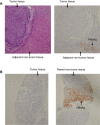Clinical, Pathological and Genetic Characteristics of Pediatric Hepatocellular Carcinoma Associated with Hepatitis B Virus Infection
- PMID: 34007834
- PMCID: PMC8121272
- DOI: 10.2147/JHC.S306963
Clinical, Pathological and Genetic Characteristics of Pediatric Hepatocellular Carcinoma Associated with Hepatitis B Virus Infection
Abstract
Introduction: Hepatocellular carcinoma (HCC) remains the major challenge in the management of patients with hepatitis B virus (HBV) infection. To date, limited studies have been done on pediatric HBV-associated HCC specifically.
Methods: Pediatric patients younger than 16 years with HBV-associated HCC were included in the study. HBV integration detection was performed using a high-throughput viral integration detection (HIVID) method.
Results: Among the 13 included pediatric patients, boys predominated (10, 76.9%). The median age at diagnosis of HCC was 13 years and the youngest age was 6 years. Nine patients had initially seronegative hepatitis B e antigen (HBeAg) and 4 had seropositive HBeAg. All patients had cirrhosis and elevated alpha-fetoprotein. Splenomegaly was present in all patients. Intrahepatic HBsAg was not detected in any tumor tissues from 5 patients who underwent biopsy or excision, while it was positive in all matched non-tumor tissues. In the tumor and matched non-tumor tissues from 3 individuals, HBV integration was identified except in the neoplastic specimen from 1 patient. Integration into the reported genes associated with hepatocarcinogenesis was not found in the tumor tissues from the 3 patients.
Discussion: Hypervigilance for HCC development is required in HBeAg-negative cirrhotic children. The findings based on the immunohistochemical and genetic results expand the knowledge of pediatric HCC development.
Keywords: children; hepatitis B virus; hepatocellular carcinoma.
© 2021 Zhao et al.
Conflict of interest statement
The authors report no conflicts of interest in this work.
Figures


Similar articles
-
Intrahepatic distribution of hepatitis B virus antigens in patients with and without hepatocellular carcinoma.World J Gastroenterol. 2016 Mar 28;22(12):3404-11. doi: 10.3748/wjg.v22.i12.3404. World J Gastroenterol. 2016. PMID: 27022222 Free PMC article.
-
Among Patients with Undetectable Hepatitis B Surface Antigen and Hepatocellular Carcinoma, a High Proportion Has Integration of HBV DNA into Hepatocyte DNA and No Cirrhosis.Clin Gastroenterol Hepatol. 2020 Feb;18(2):449-456. doi: 10.1016/j.cgh.2019.06.029. Epub 2019 Jun 25. Clin Gastroenterol Hepatol. 2020. PMID: 31252193
-
Chronic hepatitis B virus infection in Asian countries.J Gastroenterol Hepatol. 2000 Dec;15(12):1356-61. doi: 10.1046/j.1440-1746.2000.0150121356.x. J Gastroenterol Hepatol. 2000. PMID: 11197043 Review.
-
Synergistic effects of family history of hepatocellular carcinoma and hepatitis B virus infection on risk for incident hepatocellular carcinoma.Clin Gastroenterol Hepatol. 2013 Dec;11(12):1636-45.e1-3. doi: 10.1016/j.cgh.2013.04.043. Epub 2013 May 10. Clin Gastroenterol Hepatol. 2013. PMID: 23669307 Free PMC article.
-
What can we learn from hepatitis B virus clinical cohorts?Liver Int. 2015 Jan;35 Suppl 1:91-9. doi: 10.1111/liv.12716. Liver Int. 2015. PMID: 25529093 Review.
Cited by
-
A quick algorithmic review on management of viral infectious diseases in pediatric solid organ transplant recipients.Front Pediatr. 2023 Sep 4;11:1252495. doi: 10.3389/fped.2023.1252495. eCollection 2023. Front Pediatr. 2023. PMID: 37732007 Free PMC article. Review.
References
LinkOut - more resources
Full Text Sources
Other Literature Sources

